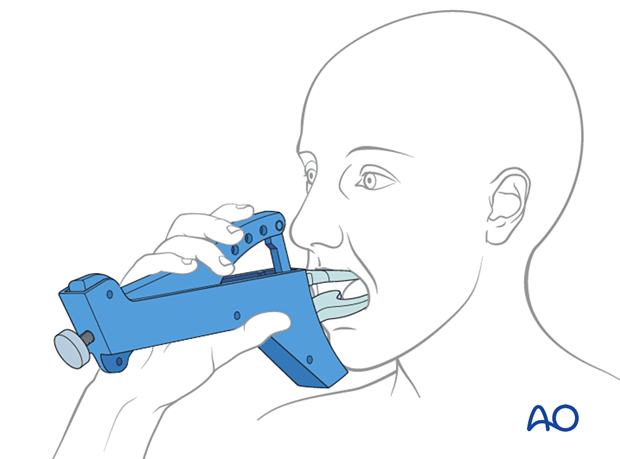ORIF, load bearing plate with or without simplification
1. Principles
General considerations
Load-bearing fixation is indicated for open surgical treatment in all types of complex fractures in the mandibular symphysis (comminuted, chronically infected simple fractures, and segmental defects).
- A detailed discussion of load-bearing versus load-sharing fixation
Further information on the fixation of infected fractures with or without bone loss can be found in the respective hyperlinks.
If a reconstruction plate is used because of a history of chronic infection, the mandible's infected area should be spanned without using screws close to the area of infection within that area. The placement of at least three screws in the uninvolved bone on each side of the fracture is required.
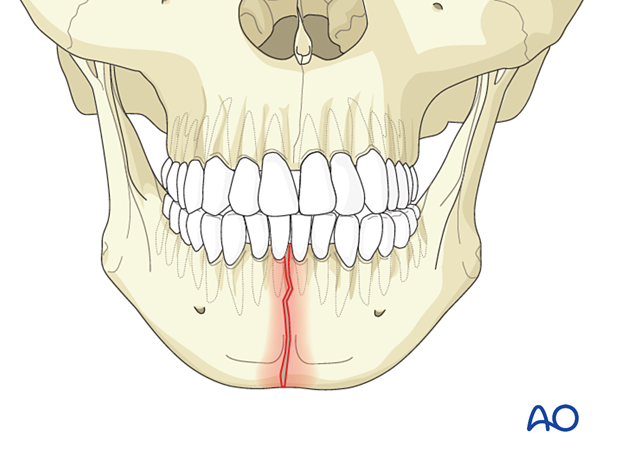
Bone defects may be managed primarily or secondarily. If there is good soft tissue available for tension-free closure over the bone graft, osseous defects may be primarily bone-grafted. Otherwise, secondary bone grafting reconstruction is advisable.
If a secondary reconstruction is planned, the use of a temporary external fixator may be considered.
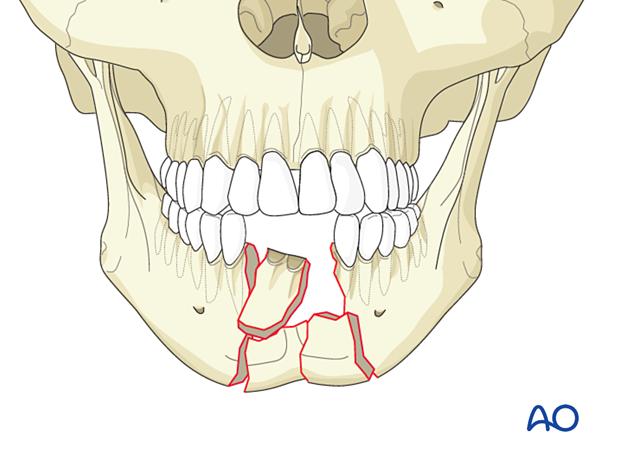
Although there is a risk of subsequent infection, sequestration, or bone loss, primary ORIF is the treatment of choice for comminuted fractures.
The load-bearing fixation bridges the area of comminution. The bone fragments within the comminuted area will not provide any support to the construct. The reconstruction plate should be fixed with at least three, preferably four screws on each side of the comminuted area.
To illustrate the principles, the remainder of this procedure will focus on the comminuted fractures.
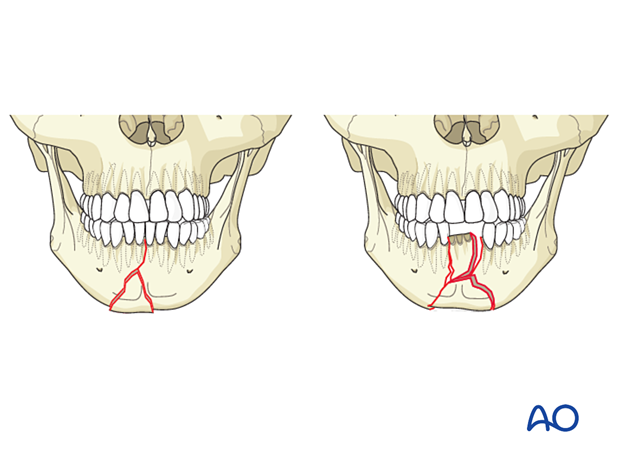
Keys to success
The keys to a successful result are:
- Fracture simplification with adequate three-dimensional fragment reduction and fixation
- Proper alignment of the alveolar segments to restore preoperative occlusion
- Application of a well-adapted reconstruction plate, bridging unstable segments
Other considerations
Following special considerations may need to be taken into account:
Click on any subject for further detail.
Stepwise repair: simplification before load-bearing reconstruction
When treating comminuted mandibular symphysis fractures, the surgeon should proceed in a stepwise fashion:
- Place the patient in occlusion and secure MMF
- Simplify comminuted fractures using miniplates
- Perform the load-bearing fixation
When simplification is performed, small fragments within a comminuted area are reduced and fixed to each other to build up larger bone fragments that will fit into the gap. These compound bone fragments are used to realign the overall bone shape (anatomic reduction) and help contour the reconstruction plate along the reduced lower mandibular border.
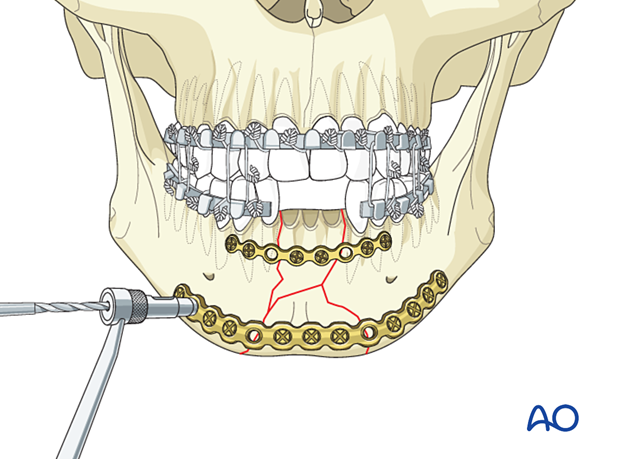
Zones for screw placement in the mandibular body
Two structures must not be harmed by screw insertion:
- the mandibular canal with the inferior alveolar nerve
- the tooth roots.
The classical description for screw placement in plate and screw osteosynthesis is depicted for orientation. Monocortical screws can be inserted above the level of the mandibular canal. The use of bicortical screws is restricted to the area below the nerve canal at the lower mandibular border.
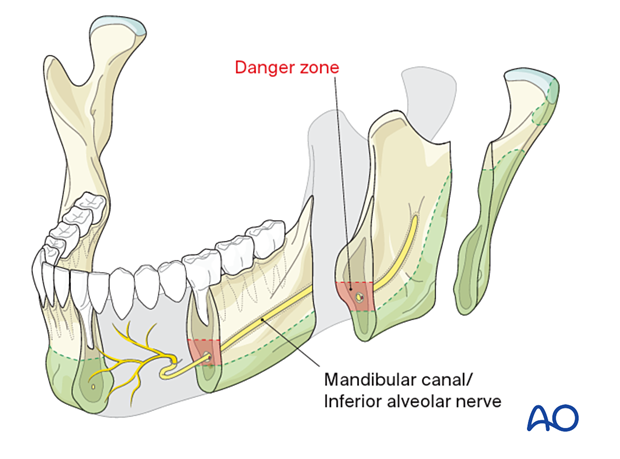
Bicortical screws should be inserted more than 5-6 mm caudal to the mental foramen because of the inferior alveolar nerve path in this area.

2. Patient preparation
This procedure is typically performed with the patient placed in a supine position.
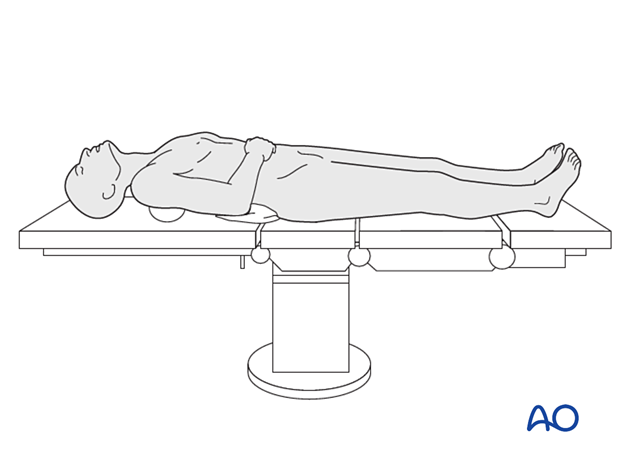
3. Selection of approach
For this procedure, the transoral approach to the symphysis is typically used.
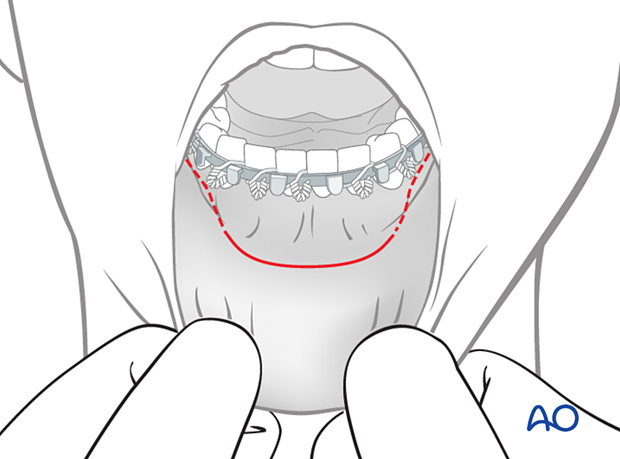
Depending on the fracture's severity and/or the presence of a suitable laceration, a transcutaneous approach via the submental route may be indicated.
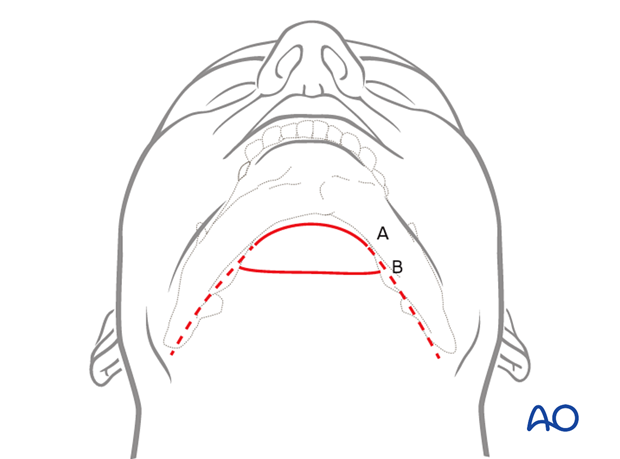
4. Plate selection
For load-bearing fixation, a locking reconstruction plate should be used.
The plate must be long enough to allow for the placement of a minimum of three or preferably four screws on each side of the comminuted zone. The screws adjacent to the fracture should be at least 7 mm away from the fracture line. Most commonly, there will be one or two holes without screws located over the fracture.
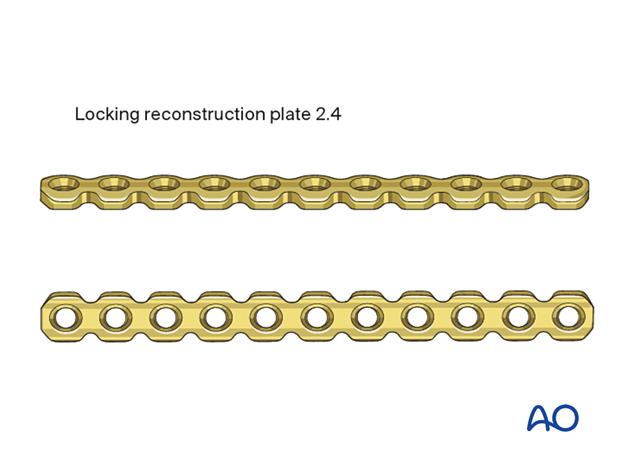
5. Reduction
MMF
The fracture is exposed, and any tooth extractions deemed necessary are performed. The bones should also be reduced before placing the dentate patient into occlusion and securing the MMF.
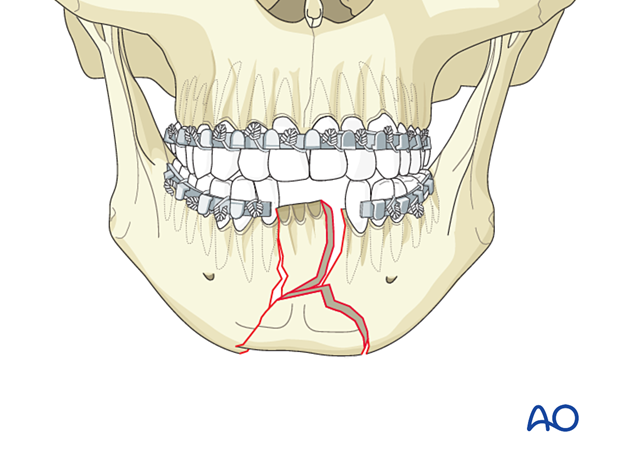
Fracture reduction
The comminuted fragments can be positioned using bone screws as a handle.

6. Simplification
The superior border (alveolar process) fragments are reduced to create one "large fragment," also referred to as simplification of the comminuted fragments. The reduction is performed manually or with the use of elevators or bone hooks.
One or several miniplates are cut, contoured, and applied to secure the simplified fragment to the non-fractured mandibular proximal and distal mandible using monocortical screws.
One long plate can be used to span and hold all alveolar process fragments at once but can be more complicated to apply than several short plates. The use of small plates allows for fine-tuning each fragment's reduction before inserting the load-bearing (basal) plate.
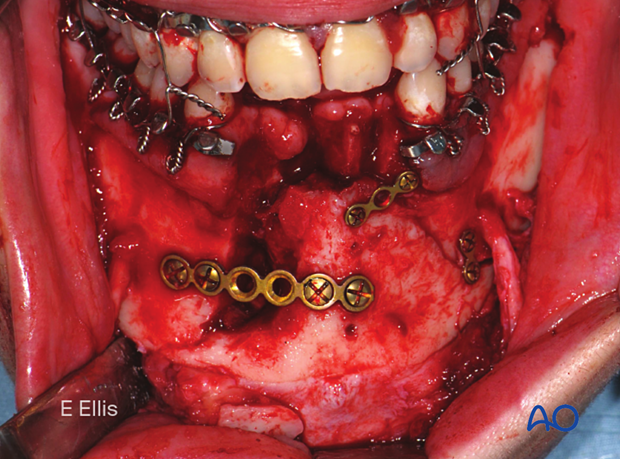
7. Application of the lower border reconstruction plate
Plate contouring
The use of a malleable template is strongly advocated for accurate plate contouring.
The risk of mental nerve injury is reduced because the plate will not have to be reintroduced multiple times during the bending procedure.
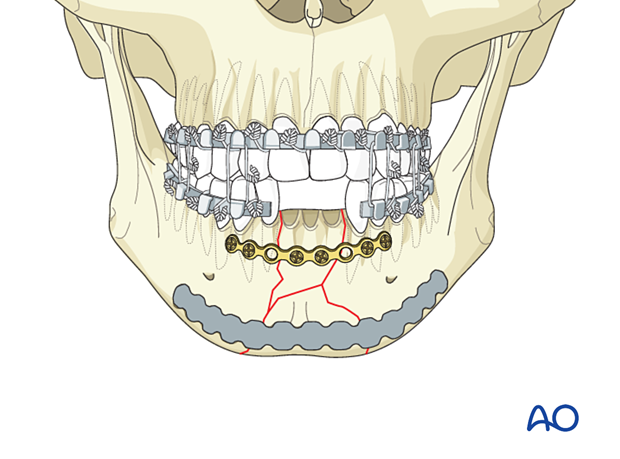
The plate must be contoured to the mandible surface and flush with the inferior border to avoid injuring the mental and inferior alveolar nerves.
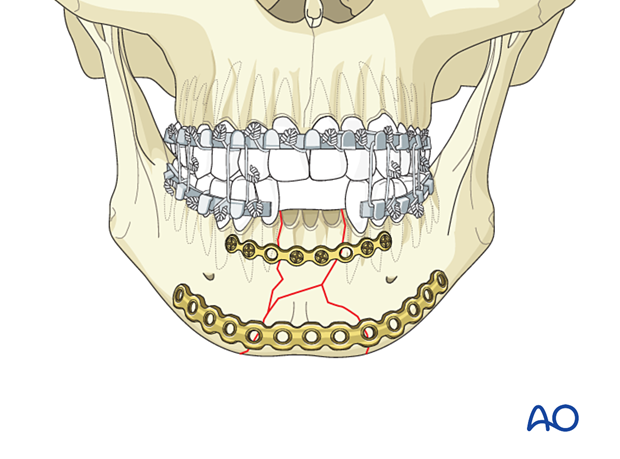
Screw insertion
Threaded drill guides should always be used to center the screw within the locking reconstruction plate.
A crucial point is choosing the appropriate screw length so that the far tip of the screw fully engages the far cortex, with the screw tip exiting slightly beyond the bone's lingual cortex.
Large fragments can be secured to the plate to hold them in position.

This clinical image shows the final construct.
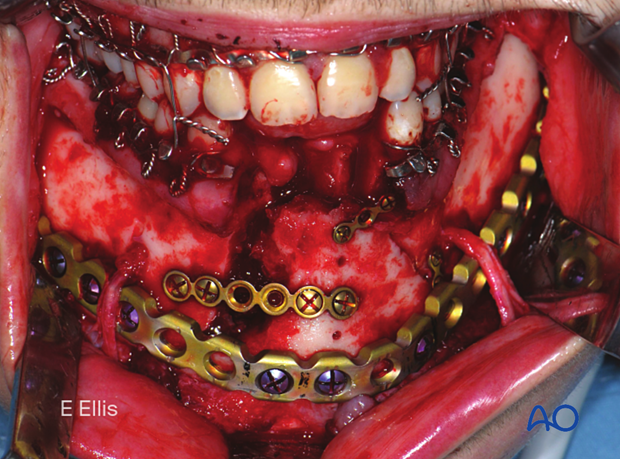
Final check
Release the MMF and check the occlusion before proceeding with closure.
Outcome
X-ray shows the completed osteosynthesis 12 weeks postoperatively.
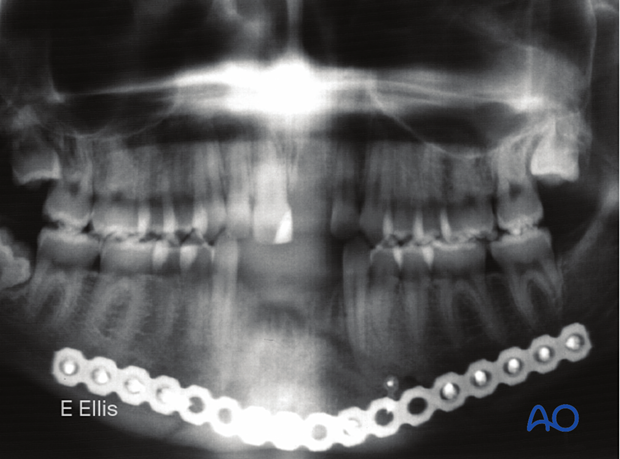
8. Aftercare following ORIF of mandibular symphysis, body, angle, and ramus fractures
Use of jaw bra
If significant degloving of the soft tissues of the mandible has occurred, there may be a consideration for using a jaw bra or similar support dressing.
Arch bars
If arch bars or MMF screws are used intraoperatively, they are usually removed at the conclusion of surgery if proper fracture reduction and fixation have been achieved. Arch bars may be maintained postoperatively if functional therapy is required or if required as part of the fixation.
X-Rays
Postoperative x-rays are taken within the first days after surgery. In an uneventful course, follow-up x-rays are taken after 4–6 weeks.
Follow up
The patient is examined approximately 1 week postoperatively and periodically thereafter to assess the stability of the occlusion and to check for infection of the surgical wound. During each visit, the surgeon must evaluate the patient's ability to perform adequate oral hygiene and wound care and provide additional instructions if necessary. Many patients need to be seen regularly for replacement of their intermaxillary elastics and to encourage range of motion in their TMJ in the later course of the treatment.
Follow-up appointments are at the discretion of the surgeon and depend on the stability of the occlusion on the first visit. If a malocclusion is noted and treatable with training elastics, weekly appointments are recommended.
The patient should be warned to continue routine follow up with their dentist. Fractures near the dental roots can often result in delayed loss of tooth viability, requiring periapical films and additional dental procedures.
Malocclusion
If a malocclusion is detected, the surgeon must ascertain its etiology (with appropriate imaging technique). If the malocclusion is secondary to surgical edema or muscle splinting, training elastics may be beneficial. The lightest elastics as possible are used for guidance, because active motion of the mandible is desirable. Patients should be shown how to place and remove the elastics using a hand mirror.
If the malocclusion is secondary to a bony problem due to inadequate reduction or hardware failure or displacement, elastic training will be of no benefit. The patient must return to the operating room for revision surgery.
Basic postoperative instructions
DietDepending upon the stability of the internal fixation, the diet can vary between liquid and semi-liquid to “as tolerated”, at the discretion of the surgeon. Any elastics are removed during eating.
Patients having only extraoral approaches are not compromised in their routine oral hygiene measures and should continue with their daily schedule.
Patients with intraoral wounds must be instructed in appropriate oral hygiene procedures. The presence of the arch-bars and any elastics makes this a more difficult procedure than normal. A soft toothbrush (dipping in warm water makes it softer) should be used to clean the surfaces of the teeth and arch-bars. Any elastics are removed for oral hygiene procedures. Chlorhexidine oral rinses should be prescribed and used at least three times each day to help sanitize the mouth. Chlorohexidine may cause staining of the teeth and should not be used longer than necessary. For larger debris, a 1:1 mixture of hydrogen peroxide (0.25%)/chlorhexidine (0.12%) can be used. The bubbling action of the hydrogen peroxide helps remove debris. A water flosser, providing a water jet, is a very useful tool to help remove debris from the wires. If a this is used, care should be taken not to direct the jet stream directly over intraoral incisions as this may lead to wound dehiscence.
Physiotherapy can be prescribed at the first visit and opening and excursive exercises begun as soon as possible. Goals should be set, and, typically, 40 mm of maximum interincisal jaw opening should be attained by 4 weeks postoperatively. If the patient cannot fully open his mouth, additional passive physical therapy may be required such as Therabite® or tongue-blade training.
